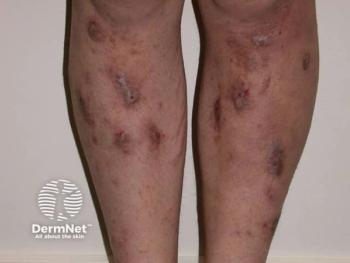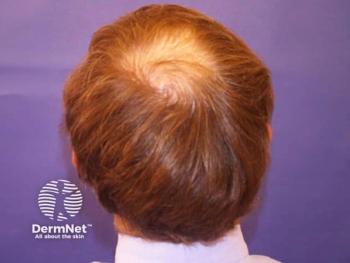
Patch testing remains underreported
Patch testing for allergic contact dermatitis in the pediatric population is performed at a higher rate than previously reported, but still grossly underreported, according to a study of the Pediatric Contact Dermatitis Registry.
Patch testing for allergic contact dermatitis in the pediatric population is performed at a higher rate than previously reported, but still grossly underreported, according to a study of the Pediatric Contact Dermatitis Registry.
Dr. Jacob“Pediatric dermatologists provide critical patch test services across the United States,” lead author Sharon Jacob, M.D., a professor of dermatology at Loma Linda University in California, tells Dermatology Times. “However, further studies are needed to fully understand the burden of this disease.”
Dr. Jacob’s interest in the study, which appears in Pediatric Dermatology, stems from her caring for children referred to her with debilitating dermatitis over the last decade.
“I evaluated these children for contact allergies, and then saw them get better with avoidance measures,” she says.
For the study, the Pediatric Contact Dermatitis Registry (PCDR) solicited a wide range of U.S. providers to join the registry by completing an online 11-question registration survey.
“The PCDR is the first national registry of its kind,” Dr. Jacob says. “It is the first national registry to evaluate pediatric allergic contact dermatitis (ACD) on a large national, interdisciplinary scale within the U.S.”
Results of the survey, which consisted of 252 respondents from all 50 states and the District of Columbia, confirmed that American adults and children are equally likely to be affected by allergic contact dermatitis (ACD).
“We showed that the low patch testing numbers reported in the literature did indeed reflect the paucity of data, rather than a low prevalence of ACD in children,” Dr. Jacob says. “We also demonstrated that a significant number of pediatric patch tests each year are not recorded in the literature.”
Cumulatively, survey respondents reported that a minimum of 1,726 to 4,613 children were patch tested yearly.
“This 14- to 37-fold increase in reported patch test evaluations compared to prior retrospective reports substantiates the value of a larger and more diversified group of participants,” Dr. Jacob says.
The lack of a commercially available patch test series with an FDA pediatric indication “has not impeded patch testing in children by specialists across multiple disciplines,” Dr. Jacob says.
A significant number of the care providers who responded to the survey were pediatric dermatologists. However, only 37.7% were a member of the American Contact Dermatitis Society (ACDS).
Systemically activated contact dermatitis in an atopic child. (Photo: Sharon Jacob, M.D.)
“Participants who were members of both the Society for Pediatric Dermatology (SPD) and the ACDS were significantly more likely to use standard comprehensive patch testing than those who were members of only one of the two societies,” Dr. Jacob says.
Of the 252 respondents, only 84 (33%) submitted pediatric patch test case data, totally 1,142 cases between January and December 2015. Yearly testing by the respondent providers who did not submit case data ranged from 1-10 cases, 11-25 cases or 51-99 cases per year, with a significant number in the mid-range.
“We conservatively estimate between 168 and 4,500 cases in 2015 from the non-reporting respondent providers,” Dr. Jacobs says. “It is notable that both reporting and non-reporting respondents represent only a fraction of the overall providers providing care for this service, meaning that reporting of ACD in pediatric patients is grossly underreported.”
This finding was recently further confirmed by the burden of skin disease study, which appeared earlier this year in the Journal of the American Academy of Dermatology. That study states that more that 13 million Americans sought care for ACD in 2013, with the disease more prevalent in children. This resulted in medical treatment costs exceeding $1.5 billion, more than for melanoma treatment.
To increase the report rate, “we need to make reporting easier by streamlining,” says Dr. Jacob, president of the American Contact Dermatitis Society. “Also, to incentivize clinicians by providing this data back to them to improve patient care.”
Patch test efficacy can be improved by screening with an appropriate composite of core relevant allergens and stressing the importance and necessity of delayed readings.
“Some providers fail to do a delayed reading,” Dr. Jacob says. “The test is to be removed by 48 hours and then evaluated. The test should also be reread between 72 hours and 120 hours.”
Emphasizing the importance of post-patch evaluation education for allergen avoidance is critical as well.
To improve the safety of patch testing, standardization and removal of known irrelevant allergens would help, according to Dr. Jacob.
“Given that fully comprehensive standardized testing is not universally available, supplemental synchronous testing of highly relevant allergens and omission of lower prevalence allergens, not indicated by history, could improve patch test efficacy and safety,” she says.
The ACDS has developed a Pediatric Contact Dermatitis Workgroup, which is meeting in November to provide guidance on best practice measures for synchronous testing.
“When comprehensive, history-based patch testing is not available, synchronous testing would be best practice,” Dr. Jacob says. “This includes the known frequent allergens that are not on the commercially available kit, along with removal of the allergens from the kit with low relevance in children.”
Disclosures
Dr. Jacob reports no relevant financial disclosures. The project was supported by a Society of Pediatric Dermatology Pilot Project grant.
References
Jacob, S. E., Lipp, M. B., Suh, E. and Goldenberg, A. (2017), Practice Patterns of Dermatologists in the Pediatric Contact Dermatitis Registry.
Lim HW, Collins SAB, Resneck JS, et al. The burden of skin disease in the United States. J Am Acad Dermatol. 2017;76:958-72.
Newsletter
Like what you’re reading? Subscribe to Dermatology Times for weekly updates on therapies, innovations, and real-world practice tips.


















